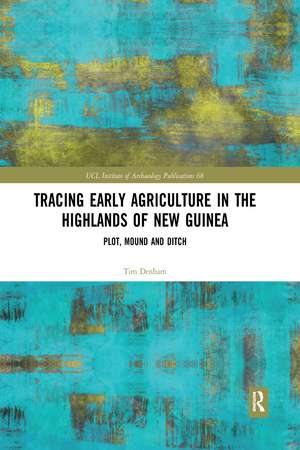Tracing Early Agriculture in the Highlands of New Guinea: Plot, Mound and Ditch: UCL Institute of Archaeology Publications
Autor Tim Denhamen Limba Engleză Paperback – 14 aug 2020
The multi-disciplinary record from the highlands has the potential to challenge and change long held assumptions regarding early agriculture globally, which are usually based on domestication. Early agriculture in the highlands is charted by an exposition of the practices of plant exploitation and cultivation. Practices are ontologically prior because they ultimately produce the phenotypic and genotypic changes in plant species characterised as domestication, as well as the social and environmental transformations associated with agriculture. They are also methodologically prior because they emplace plants in specific historico-geographic contexts.
Din seria UCL Institute of Archaeology Publications
- 18%
 Preț: 782.47 lei
Preț: 782.47 lei -
 Preț: 418.17 lei
Preț: 418.17 lei -
 Preț: 288.81 lei
Preț: 288.81 lei -
 Preț: 349.74 lei
Preț: 349.74 lei - 17%
 Preț: 340.23 lei
Preț: 340.23 lei -
 Preț: 312.56 lei
Preț: 312.56 lei -
 Preț: 502.75 lei
Preț: 502.75 lei - 31%
 Preț: 765.68 lei
Preț: 765.68 lei - 20%
 Preț: 245.83 lei
Preț: 245.83 lei -
 Preț: 352.41 lei
Preț: 352.41 lei -
 Preț: 364.44 lei
Preț: 364.44 lei - 25%
 Preț: 1022.48 lei
Preț: 1022.48 lei -
 Preț: 386.32 lei
Preț: 386.32 lei -
 Preț: 414.53 lei
Preț: 414.53 lei - 30%
 Preț: 988.16 lei
Preț: 988.16 lei -
 Preț: 370.87 lei
Preț: 370.87 lei -
 Preț: 384.02 lei
Preț: 384.02 lei - 15%
 Preț: 582.24 lei
Preț: 582.24 lei -
 Preț: 368.76 lei
Preț: 368.76 lei -
 Preț: 345.39 lei
Preț: 345.39 lei - 17%
 Preț: 240.42 lei
Preț: 240.42 lei - 20%
 Preț: 242.08 lei
Preț: 242.08 lei - 26%
 Preț: 1044.60 lei
Preț: 1044.60 lei - 18%
 Preț: 784.67 lei
Preț: 784.67 lei - 29%
 Preț: 1020.09 lei
Preț: 1020.09 lei - 25%
 Preț: 364.86 lei
Preț: 364.86 lei -
 Preț: 349.53 lei
Preț: 349.53 lei - 15%
 Preț: 669.94 lei
Preț: 669.94 lei - 18%
 Preț: 1128.91 lei
Preț: 1128.91 lei - 18%
 Preț: 1082.83 lei
Preț: 1082.83 lei - 21%
 Preț: 247.50 lei
Preț: 247.50 lei -
 Preț: 354.71 lei
Preț: 354.71 lei - 19%
 Preț: 241.15 lei
Preț: 241.15 lei - 16%
 Preț: 264.12 lei
Preț: 264.12 lei - 19%
 Preț: 246.84 lei
Preț: 246.84 lei - 30%
 Preț: 1014.74 lei
Preț: 1014.74 lei -
 Preț: 349.05 lei
Preț: 349.05 lei
Preț: 395.47 lei
Nou
Puncte Express: 593
Preț estimativ în valută:
75.68€ • 82.18$ • 63.57£
75.68€ • 82.18$ • 63.57£
Carte tipărită la comandă
Livrare economică 22 aprilie-06 mai
Preluare comenzi: 021 569.72.76
Specificații
ISBN-13: 9780367589073
ISBN-10: 0367589079
Pagini: 216
Dimensiuni: 219 x 276 x 13 mm
Greutate: 0.59 kg
Ediția:1
Editura: Taylor & Francis
Colecția Routledge
Seria UCL Institute of Archaeology Publications
Locul publicării:Oxford, United Kingdom
ISBN-10: 0367589079
Pagini: 216
Dimensiuni: 219 x 276 x 13 mm
Greutate: 0.59 kg
Ediția:1
Editura: Taylor & Francis
Colecția Routledge
Seria UCL Institute of Archaeology Publications
Locul publicării:Oxford, United Kingdom
Cuprins
TABLE OF CONTENTS
PART I. RETHINKING EARLY AGRICULTURE
CHAPTER 1. EARLY AGRICULTURE IN THE HIGHLANDS: AN UNEXPECTED STORY; CHAPTER 2.
PART II. PLACES, PRACTICES AND PLANTS
DEFINING EARLY AGRICULTURE IN NEW GUINEA; CHAPTER 3. THE IMPORTANCE OF PLACE; CHAPTER 4. CULTIVATION PRACTICES IN THE HIGHLANDS; CHAPTER 5. THE PLANTS OF HIGHLAND CULTIVATION
PART III. PRACTICES IN THE PAST
CHAPTER 6: EXPLOITING DIVERSITY IN THE PLEISTOCENE; CHAPTER 7: AMBIGUITIES OF PRACTICE DURING THE EARLY HOLOCENE; CHAPTER 8. THE EMERGENCE OF SHIFTING CULTIVATION; CHAPTER 9. THE ADOPTION OF MOUND CULTIVATION DURING THE MID HOLOCENE; CHAPTER 10. THE DIGGING OF DRAINAGE DITCHES DURING THE LATE HOLOCENE; CHAPTER 11. LATER INNOVATIONS, INTRODUCTIONS AND ADOPTIONS
PART IV. TAKING A BROADER VIEW
CHAPTER 12. HISTORICAL RESILIENCE OF AGRICULTURE IN THE HIGHLANDS; CHAPTER 13. THE GLOBAL SIGNIFICANCE OF EARLY AGRICULTURE ON NEW GUINEA; BIBLIOGRAPHY; INDEX
PART I. RETHINKING EARLY AGRICULTURE
CHAPTER 1. EARLY AGRICULTURE IN THE HIGHLANDS: AN UNEXPECTED STORY; CHAPTER 2.
PART II. PLACES, PRACTICES AND PLANTS
DEFINING EARLY AGRICULTURE IN NEW GUINEA; CHAPTER 3. THE IMPORTANCE OF PLACE; CHAPTER 4. CULTIVATION PRACTICES IN THE HIGHLANDS; CHAPTER 5. THE PLANTS OF HIGHLAND CULTIVATION
PART III. PRACTICES IN THE PAST
CHAPTER 6: EXPLOITING DIVERSITY IN THE PLEISTOCENE; CHAPTER 7: AMBIGUITIES OF PRACTICE DURING THE EARLY HOLOCENE; CHAPTER 8. THE EMERGENCE OF SHIFTING CULTIVATION; CHAPTER 9. THE ADOPTION OF MOUND CULTIVATION DURING THE MID HOLOCENE; CHAPTER 10. THE DIGGING OF DRAINAGE DITCHES DURING THE LATE HOLOCENE; CHAPTER 11. LATER INNOVATIONS, INTRODUCTIONS AND ADOPTIONS
PART IV. TAKING A BROADER VIEW
CHAPTER 12. HISTORICAL RESILIENCE OF AGRICULTURE IN THE HIGHLANDS; CHAPTER 13. THE GLOBAL SIGNIFICANCE OF EARLY AGRICULTURE ON NEW GUINEA; BIBLIOGRAPHY; INDEX
Notă biografică
Dr Tim Denham is Reader/Associate Professor of Archaeology at the Australian National University. He has undertaken fieldwork in Papua New Guinea, mostly in the highland interior, since 1990. His primary research has focussed on plant exploitation and the emergence of agriculture in the highlands during the Holocene. He has also published on the Holocene histories of Island Southeast Asia and northern Australia. Over the last decade, his interests have diversified to include: the domestication of vegetatively propagated crops, especially bananas; geoarchaeology and environmental change, mainly in the wet tropics; and, the application of new technologies to archaeological questions.
Descriere
In this book, historical narratives chart how people created forms of agriculture in the highlands and how these practices were transformed through time. Tracing Early Agriculture in the Highlands of New Guinea is for a new audience, one that is not necessarily familiar with the geographical and historical nuances of the island of New Gui
